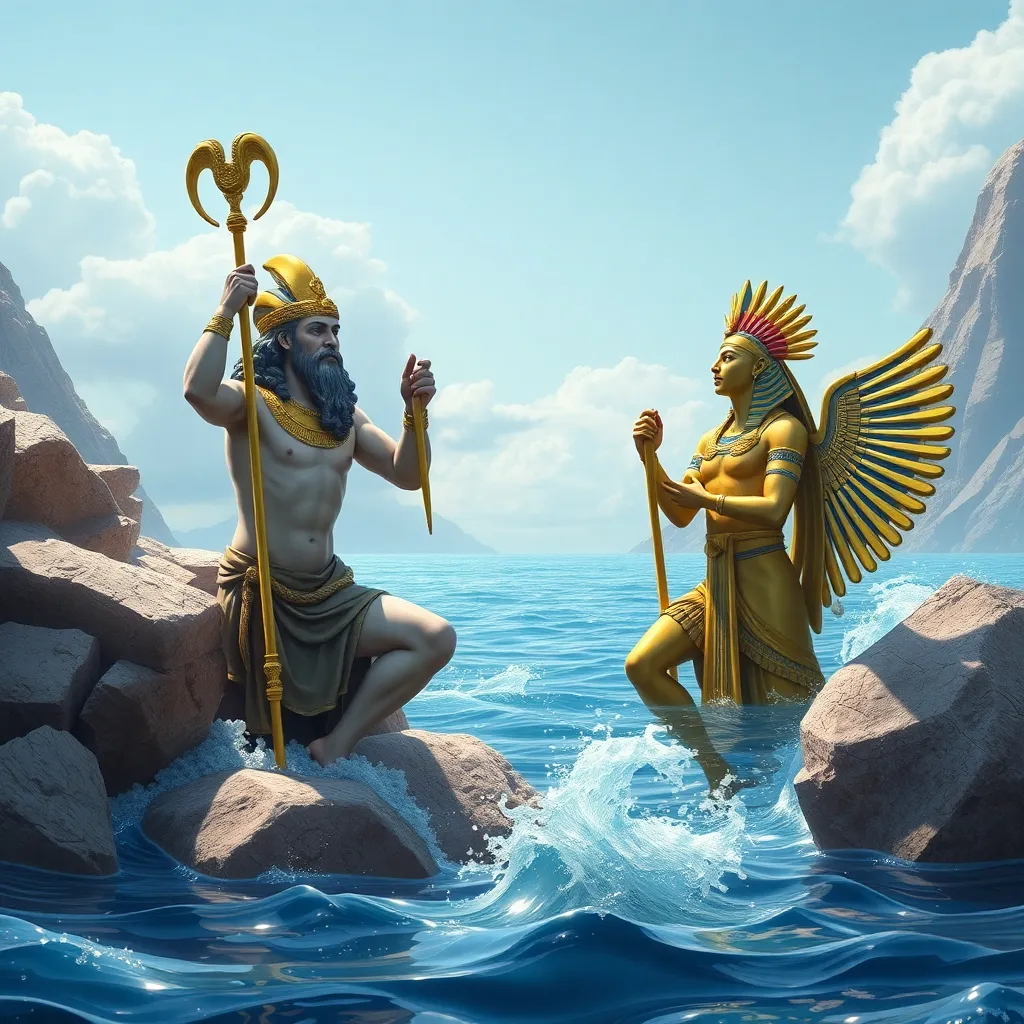The Cultural Interactions Between Poseidon and Egyptian Deities
I. Introduction
Greek and Egyptian mythologies stand as two of the most influential and rich mythological traditions in the ancient world. At the heart of Greek mythology is Poseidon, the formidable god of the sea, earthquakes, and horses. His significance in the pantheon of Greek deities is profound, affecting not only the natural world but also human endeavors and cultural practices.
In contrast, ancient Egyptian mythology boasts a complex array of deities, each with their own domains and attributes, often closely tied to the life-giving Nile River. This article aims to explore the cultural interactions and shared themes between Poseidon and various Egyptian deities, particularly those associated with water. Through this examination, we gain insights into how these two ancient cultures influenced one another and how their mythologies reflect their respective environments.
II. The Role of Poseidon in Greek Mythology
Poseidon, the brother of Zeus and Hades, holds a prominent position in Greek mythology. He is revered as the god of the sea, earthquakes, and horses, wielding a trident that symbolizes his dominion over water and his ability to cause seismic disturbances.
Poseidon’s symbolism is multifaceted:
- God of the Sea: As the ruler of oceans, Poseidon was both revered and feared, capable of granting safe passage to sailors or unleashing storms.
- Earthquakes: His association with seismic activity made him a significant figure in regions prone to such natural disasters.
- Horses: Poseidon is also credited with the creation of horses, linking him to agricultural fertility and the horse-riding warrior culture of the Greeks.
Worship of Poseidon was widespread, with numerous temples dedicated to him, including the famous Temple of Poseidon at Sounion. Rituals and offerings were made to appease him, especially by those who relied on the sea for their livelihood.
III. Overview of Key Egyptian Deities
Egyptian mythology features a vast pantheon of gods, each overseeing different aspects of life and nature. Among these deities, several are particularly relevant to water and fertility:
- Hapi: The god of the Nile, Hapi was celebrated as the provider of fertility and abundance, crucial to the agricultural success of ancient Egypt.
- Sobek: The crocodile-headed god related to the Nile, Sobek was worshiped for his protective qualities and association with the waters and fertility.
The Nile River was the lifeblood of ancient Egypt, shaping its agricultural practices, settlement patterns, and religious beliefs. The annual flooding of the Nile was seen as a divine blessing, rejuvenating the land and ensuring prosperity.
IV. Comparative Analysis of Water Symbolism
Water plays a central role in both Greek and Egyptian mythologies, symbolizing life, fertility, and the forces of nature. However, the perspectives on water differ significantly:
- Source of Life: In both cultures, water is viewed as essential for life. The Greeks revered the sea for its bountiful resources, while Egyptians celebrated the Nile as a life-giving river.
- Contrasting Perspectives: The Greeks often saw the sea as a chaotic and unpredictable force, while the Nile represented stability and predictability, fostering agriculture.
Mythological stories often feature water deities, such as Poseidon’s various adventures with mortals and creatures of the sea, contrasting with Hapi’s nurturing presence during the inundation of the Nile. These narratives reflect the cultural values and environmental realities of their respective societies.
V. Historical Context of Greek and Egyptian Interactions
The interactions between Greek and Egyptian cultures can be traced back to ancient trade routes and cultural exchanges. As commerce flourished, so too did the exchange of ideas and religious practices:
- Trade Routes: The Mediterranean Sea facilitated trade, leading to increased contact between the two civilizations.
- Religious Influence: Greek philosophers, such as Plato, were influenced by Egyptian thought, adopting and adapting concepts from their mythology.
- Historical Events: The conquests of Alexander the Great and the subsequent Hellenistic period saw the blending of Greek and Egyptian cultures, fostering syncretism.
VI. Artistic Representations and Iconography
Art and sculpture provide valuable insights into how these deities were perceived in their respective cultures. In Greek art, Poseidon is commonly depicted as a robust figure wielding his trident:
- Statues and coins often portray him amidst waves or riding a chariot drawn by horses.
- Vases and frescoes illustrate scenes from myths, showcasing his interactions with other gods and mortals.
Conversely, Egyptian art features water deities like Hapi and Sobek in unique ways:
- Hapi is often depicted with a potbelly, symbolizing abundance, and is shown holding the Nile’s water.
- Sobek is represented with a crocodile head, emphasizing his dual nature as both nurturing and fierce.
The cross-cultural influences are evident in the art of the Hellenistic period, where elements of both traditions can be seen merging in sculptures and reliefs.
VII. Syncretism and Adaptation of Deities
As Greek and Egyptian cultures interacted, instances of syncretism became apparent, with deities being adapted and merged:
- Combined Worship: Some regions saw the worship of both Poseidon and local water deities, reflecting a blend of beliefs.
- Adaptation Over Time: As cultures evolved, aspects of Poseidon’s character were influenced by Egyptian gods associated with water.
- Example of Serapis: A prominent example of syncretism is Serapis, a deity created under Ptolemaic rule that combined elements of Osiris and Apis with Greek influences.
VIII. Conclusion
The examination of Poseidon alongside Egyptian deities reveals a rich tapestry of cultural interactions that shaped ancient beliefs and practices. Both traditions hold water as a vital symbol of life, yet their distinct environments and cultural values influence their respective mythologies.
Understanding these connections enhances our appreciation of how ancient civilizations interacted, paving the way for the lasting impact of their mythologies on modern interpretations. The legacy of these deities continues to inspire art, literature, and thought, reminding us of the intricate weave of cultural history.
In recognizing the significance of these mythological connections, we gain insight into the shared human experience and the universal themes that transcend time and culture.




